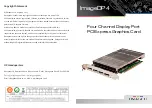
X64-AN Quad User's Manual
Theory of Operation
45
Serial Port
X64-AN Quad hosts 4 serial ports intended for camera control only. Due to data flow multiplexing of
the 4 serial ports, only one serial port can communicate at one time. Data received from a camera will
always be sent to the last serial port that sent characters. See section
page 69
for pinout information.
The default names for the serial ports are: X64-AN Quad
_
X
_Serial_
Y
, where
X
represents the X64-
AN Quad board number from 1 to 8, and
Y
represents the serial port number from 0 to 3.
Note:
A typical configuration would use 9600 baud
8-bit
no parity
1 stop bit (9600-8-N-1).
Ports can be used with their default names (for example: X64-AN Quad_1_Serial_0) by many camera
control applications. Additionally, the serial port can be mapped as a standard Windows COMx port
for convenience or compatibility with any communication program (such as HyperTerminal).
Acquisition Process
The following sections describe the various acquisition stages of the X64-AN Quad. Composite analog
video input from cameras or any other source can be processed in both the analog domain before the
A/D stage and in the digital domain before transfer to host system frame buffers.
Anti-aliasing Filter
Following a differential input buffer stage, the video passes through a low-pass filter, optimized for
standard video frequencies with a filter corner set to 12.87 MHz. When acquiring video from non-
standard sources, the low-pass filter can be bypassed with a manually set jumper (see
). Each of the four inputs has its own low-pass filter bypass
jumper.
The low-pass filter strips high frequency signal content from the incoming video signal, to avoid
sampling aliasing artifacts. Standard video (RS-170, CCIR) has useful frequency content up to
approximately 6MHz. Frequencies above this can be eliminated using the low-pass filter. Sampling
rates for standard video are 10MHz to 14MHz. If frequencies at or above the sampling rate are present
in the input, they represent noise rather than useful video. These frequencies can “alias” into the real
video signals causing corruption. The low-pass filter eliminates any high frequency signal content
before digitization. See
Input Block Diagram (one shown)
” on page 5
.















































